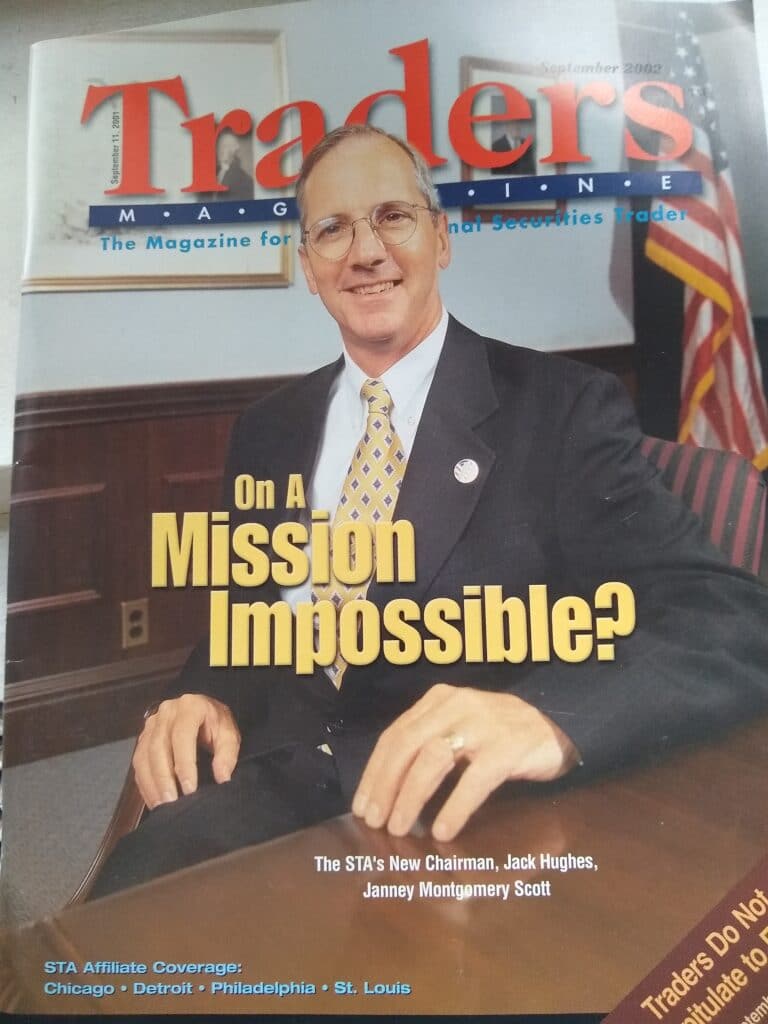This article first appeared as FLASH FRIDAY on Traders Magazine. FLASH FRIDAY is a weekly content series looking at the past, present and future of capital markets trading and technology. FLASH FRIDAY is sponsored by Instinet, a Nomura Company.
It’s no secret — the rise of computerized trading over the years has greatly reduced the need for human traders.
Full-time trading, sales and research positions at 12 of the biggest U.S. banks declined from 49,200 in 2010 to 32,200 in 2019, CNBC reported, citing Coalition data. The ranks of equity traders at Goldman Sachs have declined from 500 to 3, according to an industry anecdote cited in the CNBC report.

Industry veteran Jack Hughes foresaw the shift — somewhat. Along with many others, Hughes didn’t expect that the trading floor “football fields” of the early 2000s would become obsolete as quickly as they did.
“I didn’t see the dissipation of employment to the extent that has happened in the trading arena,” Hughes told Traders Magazine on Oct. 21.
Hughes started his career in 1976 at WH Newbold, where he spent 14 years and rose to the level of vice president and trading manager. He was profiled in Traders Magazine in 2002 as the new chairman of the Security Traders Association. At the time, he was 12 years into an 18-year tenure at Janney Montgomery Scott, where he was director of equity capital markets.
“I knew electronic trading was big, and it was necessary,” he said. “When I started in the business, a heavy volume day was 2 million shares. You could see that there was a need for more” capacity, he said.
But there is a downside to relying so heavily on machine trading, such as when a computerized feedback loop exacerbates a market decline by executing more programmatic sell orders as stocks fall.
“Human intervention would say, there may be something illogical about this, let’s stop and take a look,” Hughes said. “I didn’t anticipate we’d go as far as we did (with computerized trading). I think some of it is to the detriment of the trading system, and to the investor.”
Hughes has run his own regulatory consulting firm since 2008; his clients include Wealthforge Securities and Prodigio Trading Systems. “I was always involved in the regulatory side of the business — I always took a liking to that side,” he said.
“I’ve gotten a bit further into the weeds than I thought I would, because I’m more away from the trading compliance side, and closer to the retail and advertising side and what you can and can’t do there,” Hughes added. “I’ve grown a lot in my knowledge of the compliance side, and it’s been rewarding. I’ve met a lot more people in different aspects of our industry than ever before.”

—–
From the October 2002 Traders Magazine article “On a Mission Impossible?”:
“One of the trading industry’s new leaders has a busy year ahead of him. Here are some of the troubling issues that will be on his crowded plate: Convince ECN officials that SuperMontage will be a good deal and ADF will be an expensive nothing. Obtain vital rule changes from the Securities and Exchange Commission. And bring peace to the various parts of an often-contentious trading industry. And, to accomplish the latter, he will have to sell them on the idea that the Security Traders Association will, in fact, represent their various interests. And, while he is trying to accomplish all this, he will be leading an industry that has been floundering through the worst of times since the early 1970s.
Welcome to the STA high command, Jack Hughes.
Hughes, 52, is the Security Traders Association’s new chairman. He has an ambitious agenda for the year in which he will occupy the post. Hughes is senior vice president and director of Nasdaq and listed trading with Janney Montgomery Scott. He succeeds Michael Bird of Merrill Lynch as STA chairman. The difficulty of achieving most of his agenda can be seen in an issue such as ECN access fees. Hughes hopes the SEC will take on access fees, which is a sore point for many of his members but are acceptable to others just as they are today.”

